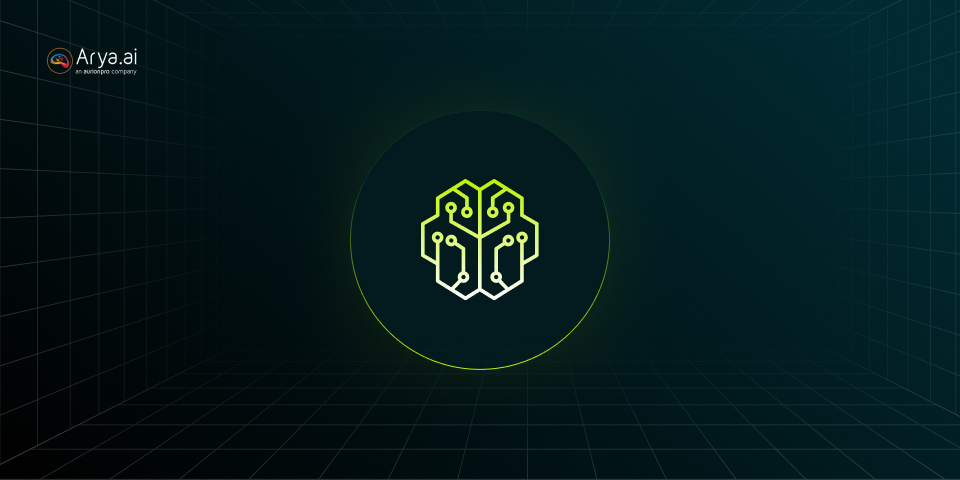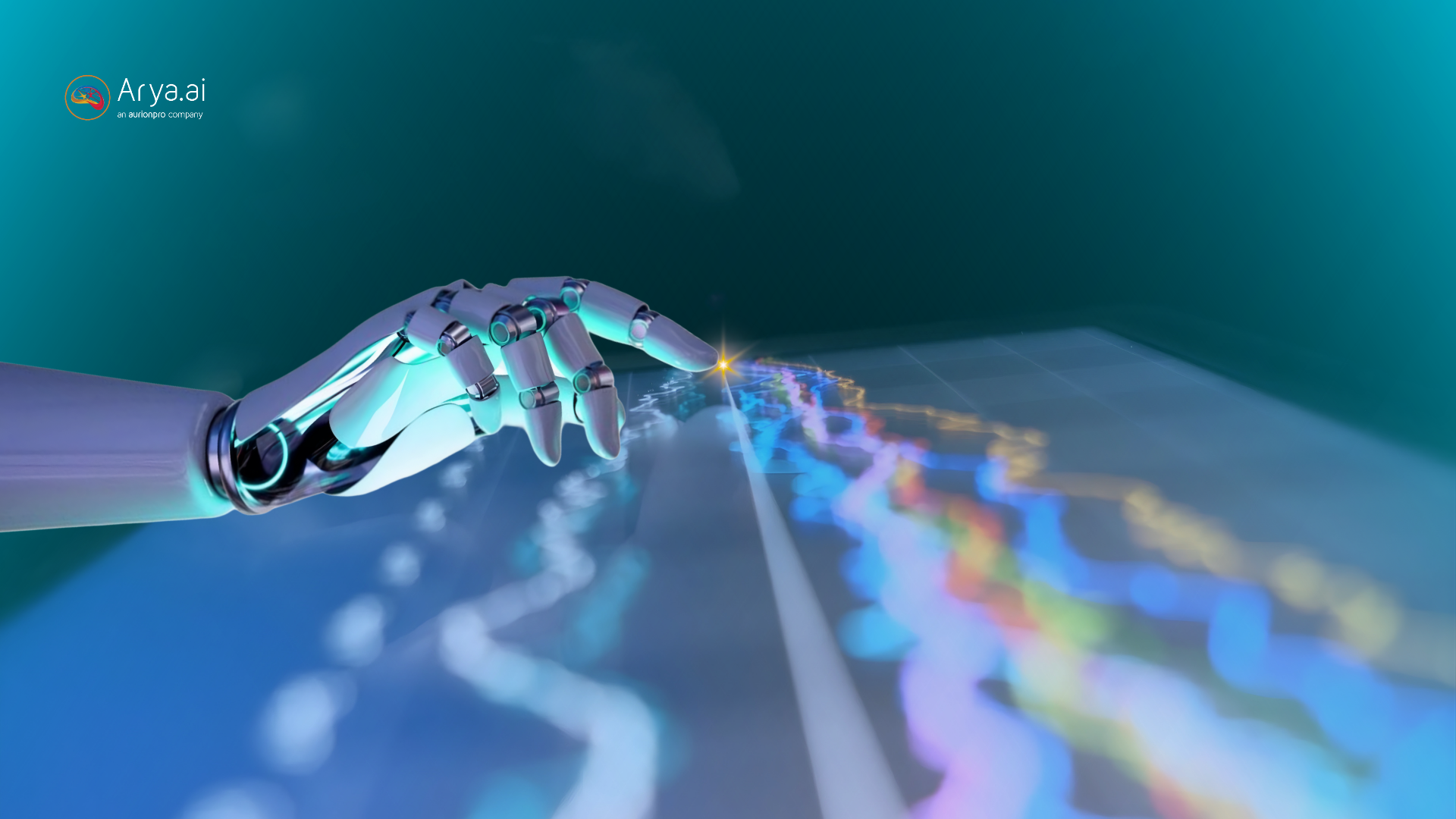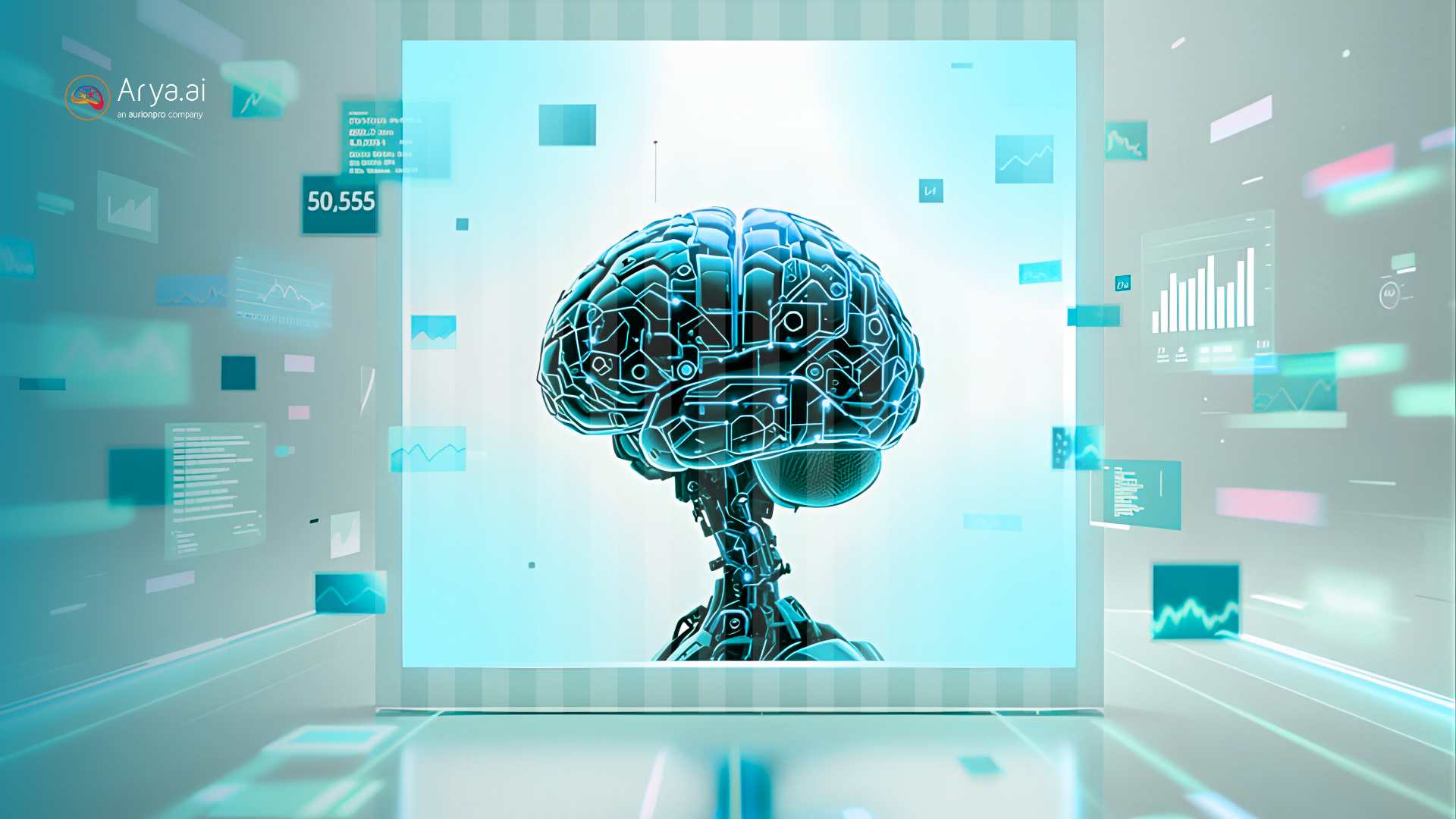
As AI systems become more powerful, the concept of AI agents has emerged as a crucial frontier in this transformation. These agents promise to fundamentally change how organizations look at automation.
Bill Gates famously said, “Agents are not only going to change how everyone interacts with computers. They’re also going to upend the software industry, bringing about the biggest revolution in computing since we went from typing commands to tapping on icons.”
AI agents are intelligent autonomous solutions that are capable of completing tasks independently after perceiving their environment.
AI agents use various AI techniques, such as machine learning, natural language processing, and neural networks, to facilitate the completion of tasks and simulate human-like decision-making capabilities.
_2.png)
The Continuous Cycle of AI Agents: Observe, Plan, and Act
AI agents do more than just respond to user queries; they operate in a continuous feedback loop—collecting data from their environment, strategizing how to meet objectives, and then executing those plans. This cyclical behavior allows them to adapt, learn from outcomes, and optimize future actions.
.jpg)
- Observe
Gather information from the environment through interfaces such as APIs, user inputs, metrics, or sensor outputs. AI agents also leverage memory to incorporate the context of past interactions. This is akin to how humans rely on both current observations and prior experiences to understand a situation.
- Plan
Evaluate and prioritize actions based on:
- Goals: What the agent (or user) intends to accomplish.
- Roles: Different agent types or “personalities,” defining how they should behave (e.g., a scheduling assistant vs. a data analysis bot).
- Reasoning Abilities: Powered by LLMs or other AI models to decompose tasks, handle complex logic, and propose solutions.
- Context & Memory: Retained from previous tasks, interactions, or data points.
- Act
Execute planned actions through:
- Interfaces to digital systems and databases (e.g., sending queries, updating records, triggering software functions).
- Delegation to other agents or third-party tools for more specialized tasks.
- Clarification prompts to users for additional input or confirmation when uncertainties arise.
This loop is what enables AI agents to refine strategies, learn from mistakes, and handle increasingly complex scenarios.
Here’s an example of an AI agent in finance deployed as an insurance assistant.

The Key Components of AI Agents

An AI agent can function through the following components:
- Perception Module: The system that collects data from the environment through sensors, APIs, or user inputs
- Processing Unit – The brain of the agent that analyzes and interprets data using AI models and algorithms
- Decision-Making Engine – The system that uses rule-based logic, reinforcement learning, or predictive analytics to determine the best course of action
- Action Mechanism – The process that executes decisions, such as automating workflows, making real-time adjustments, and responding to user queries
- Learning Module – The system that continuously improves performance using feedback loops and adaptive learning
- Communication Interface – A unit that Interacts with users or other systems via text, voice, or graphical interfaces
All of these together form an AI agent that can be used by humans and enterprises.
Why AI Agents Matter for Enterprises
Three reasons why AI agents are of importance to enterprises:
- Efficiency & Automation
- Adaptability & Personalization
- Scaling Possibilities
The most obvious benefit of any kind of automation is efficiency. For instance, RPA based automations also make things efficient, but they only take care of repetitive tasks. AI agents, however, empower enterprises to take on tasks that require ‘intelligence.’
AI agents continuously learn from user interactions and the environment, AI agents can personalize outputs—like recommending relevant content or adjusting behavior based on changing conditions.
With the ability to access multiple systems, coordinate with other agents, and handle ever-growing data streams, AI agents scale effortlessly, making them integral to enterprise-level automation and innovation efforts.
Types of AI Agents
AI agents can be broadly categorized into the following types:
- Rule-Based AI Agents (Simple Reflex Agents)
These are the most simplistic forms of AI agents that make decisions based on predefined condition-action rules that guide them on how to react to specific inputs. They are limited in terms of complexity but are quite efficient in environments where the range of possible actions is limited.
The different components that it includes are:
- Sensors: They detect specific environmental conditions like temperature, light, or motion
- Condition-action rules: These predefined rules determine how the agent responds to specific inputs
- Actuators: These execute the decisions made by the agent, translating them into physical or digital responses that alter the environment in some way, such as activating a heating system or turning on lights
- Model-Based AI Agents
These are a more advanced form of AI agents that are designed to operate in partially observable environments. They maintain a model of the world and sensor history in order to make better decisions about the current state.
The key components of a model-based AI agent include:
- State tracker: The tracker maintains information about the current state of the environment based on the world model and sensor history
- World model: Understands how the environment evolves independent of the agent and how the agent’s actions affect the environment
- Reasoning component: This uses the current state and the world model to determine the action to be taken based on condition-action rules
- Goal-Oriented AI Agents
These AI agents are designed for specific goals by planning sequences of actions to achieve the objectives. They use search and planning algorithms to find action sequences that lead to their goals.
Key components of goal-oriented AI agents are:
- Goal state: The desired resulting condition
- Planning mechanism: The ability to decide how to reach the goal state by considering possible actions and their consequences
- State evaluation: A criteria that allows the agent to assess if the actions are helping it move towards the goal or away from it
- Action selection: The process of picking the desired action from a range of options to help it reach the goal
- World model: Understanding of how actions change the environment
- Learning AI Agents
AI agents that have the ability to modify their behavior based on experience and feedback fall in this category. These agents don’t rely on pre-programmed knowledge but achieve their goals through learning or Agentic AI memory from past exposure.
Some important components of learning AI agents are:
- Performance element: The component of the agent that improves decision-making by updating knowledge based on feedback
- Critic: Provides feedback on the success or failure of the agent’s actions
- Learning element: The part of the system that determines how to modify the agent’s behavior in the future based on the critic’s feedback
- Problem generator: Suggests new actions to explore that would help in better future decisions
- Multi-Agent Systems (MAS)
These systems involve multiple agents interacting with and working in a shared environment to achieve individual or collective goals. They are further subdivided into:
- Cooperative MAS: Agents in these systems share information and resources to achieve a common goal
- Competitive MAS: In these systems, agents compete with each other within defined rules for limited resources
- Hierarchical MAS: A structured system with agents at different levels, with higher-level agents managing and coordinating lower-level agents
- Heterogeneous MAS: Different agents have different roles and skills to make the system more flexible and adaptable
The key components of MAS include:
- Communication protocols: Define how agents exchange information
- Interaction rules: Specify how agents can interact and what actions are permitted
- Resource management: Methods for handling shared resources between agents
- Coordination mechanisms: Systems for organizing agent activities and preventing conflicts
How AI Agents Work
AI agents follow a specific workflow when performing assigned tasks to achieve their goals. They work by integrating various AI techniques, depending on the task, to provide the required output. For instance, AI agents in finance will have a specific workflow to operate as a loan underwriter, onboarding manager, fraud assessment manager, and more.
To understand how AI agents work, it's helpful to break it down into a step-by-step functioning process.

1. Perception (Sensory Input)
AI agents interact with their environment through sensors or input mechanisms. The perception process involves gathering data from the surroundings, which can be visual data, text or speech, sensor data, or historical data. The AI agent processes this data to build a model of its environment, allowing it to understand the state of the world and how it should respond.
2. Decision-Making (Reasoning)
Once the AI agent perceives its environment, it needs to decide what action to take. This decision-making process often involves rule-based systems, machine learning models, and reinforcement learning.
3. Planning and Goal Setting
AI agents often need to plan a sequence of actions to achieve a goal, especially in complex environments. They break down a high-level goal into smaller and manageable tasks before optimizing certain variables to achieve the goal more efficiently and determining the best path to take to reach the goal.
4. Action (Execution)
Once an AI agent has determined a course of action, it needs to execute it in the environment. This would typically involve a physical or virtual action, such as interacting with the environment physically or virtually while also reassessing and adjusting their behavior through a continuous feedback loop.
5. Learning and Adaptation
AI agents become more efficient over time by learning from their experiences and adapting to dynamic environments. They learn through either a supervised learning method, where the correct outputs are known, or unsupervised learning, where the agent learns patterns without explicit guidance. Another way of learning is reinforcement learning, which is basically a trial-and-error method that rewards or penalizes agents based on the actions they take, thereby optimizing their behavior over time.
Risk of Autonomous Systems
Autonomous systems are designed to operate with minimal or no human intervention, making them highly efficient. Still, their use in critical areas can also pose serious challenges, both technical and ethical. For instance, autonomous finance systems being used for areas such as automated underwriting or credit decisioning must operate with vigilance.
The risks of autonomous systems could pose the following risks:
- Lack of Transparency and Accountability
One of the primary risks of autonomous systems is the ‘black-box’ problem, where the decision-making process of AI agents is not fully transparent or understandable. AI systems often work by analyzing vast amounts of data and making decisions based on complex models. When it comes to governance or finance, the lack of transparency raises concerns about accountability and could erode trust, especially if the system fails to meet ethical standards.
- Bias and Discrimination
Autonomous systems are often trained on data that reflects historical patterns. If that data includes bias based on race, gender, socioeconomic status, or other factors, the AI can sustain and even amplify these biases in decision-making. In a sensitive industry like finance, AI used for lending or credit scoring could unintentionally discriminate against specific populations based on biased historical data, further driving economic inequalities.
- Security and Vulnerability to Attacks
Autonomous systems are vulnerable to cyberattacks, including manipulation, hacking, or adversarial inputs that trick the system into making incorrect decisions. In sensitive areas, such as finance, healthcare, and governance, these attacks could have devastating consequences, leading to national security breaches or huge financial losses.
- Loss of Human Oversight and Control
The more responsibilities that autonomous systems take, the more chances of humans losing control over critical decision-making. While AI can be highly efficient, its lack of human intuition and ethical judgment means that fully autonomous systems may make decisions that are undesirable or unethical. In public governance, over-reliance on autonomous systems could affect citizens' rights, health, or welfare.
- Ethical Dilemmas
While AI agents can process data and optimize for goals, they struggle with moral and ethical judgment in complex situations. In situations where the right course of action is ambiguous or depends on subjective values, these systems may struggle. For e.g., AI algorithms used in financial tools might prioritize maximizing profits at the expense of social responsibility or environmental impact, thereby affecting broader societal goals such as sustainability or equitable growth.
- Complexity and Lack of Coordination
AI agents could behave unpredictably when interacting with other autonomous systems, leading to inefficiencies or worse, systemic failure. This is prone to happen when AI systems become more complex and interconnected, needing to work harmoniously with each other.
Best Practices for Implementing AI Agents
A series of considerations and practical steps are required in order to implement AI agents effectively. Implementing AI agents successfully requires a strategic approach that balances technical capabilities with ethical considerations, ensuring that they are effective, reliable, and safe. Here are some of the best practices for implementing AI agents, especially in complex or sensitive environments:
- Define clear objectives and use cases: Having a clear understanding of the specific task the AI agent is meant to perform ensures that it can be trained properly and aligned with business goals.
- Ensure data quality and relevance: As AI agents rely heavily on data, ensuring high-quality, diverse, and unbiased data enables the systems to make accurate decisions.
- Select the right algorithms and models: With a wide variety of AI agents available, choosing the most appropriate AI algorithms specific to the problem at hand is imperative.
- Maintain human oversight: In sensitive domains such as healthcare, governance, and finance, where the consequences of mistakes are significant, adding a human layer to oversee the process enables the AI agent to perform its tasks flawlessly.
- Implement ethical guidelines and governance: Ensuring fairness, privacy, and accountability by establishing ethical frameworks and governance.
- Focus on transparency: To mitigate the ‘black-box’ problem associated with AI systems, being clear and explaining why a particular decision was reached helps in establishing trust for the AI agents.
- Prioritize security and robustness: Implementing strong security protocols to safeguard AI agents from cyberattacks, data manipulation, and adversarial inputs needs to be a priority.
- Ensure continuous monitoring and evaluation: AI agents need continuous monitoring and evaluation to ensure they adapt to changes in the environment and get more efficient and accurate.
- Test and validate in real-world scenarios: Ensuring that AI agents undergo rigorous testing before full deployment to identify any risks or flaws before widespread use.
The Future of AI Agents in Enterprises
The future of AI agents in enterprises is poised for rapid. These AI agents will become more adept at handling complex tasks, enhancing decision-making, and automating operations across industries.
Emerging trends such as AI-powered personalization, predictive analytics, and intelligent automation are reshaping how businesses interact with customers and streamline workflows. AI agents are set to revolutionize industries from finance and healthcare to manufacturing, providing more efficient solutions, deeper insights, and improved customer experiences.
However, as AI agents become more integral to enterprise operations, ethical considerations will become increasingly critical. Businesses will need to focus on transparency, fairness, and accountability to avoid biases, ensure privacy, and maintain public trust.
Ethical frameworks must guide AI development. To successfully integrate AI agents, enterprises must adopt transformation strategies that blend technological advancements with human expertise, ensuring a balanced approach to innovation. By fostering collaboration between AI systems and human workers, businesses can unlock new value while mitigating risks.





.png)





.png)




.png)
.svg)


